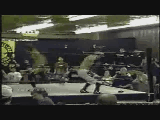
Low Ki performing his signature move Tidal Crush
A kick is an attack using the foot, knee or leg to strike any part of the opponent's body.There are a wide variety of kicking moves in pro wrestling, and many moves are known by several different names.Usually a small wrestler or a wrestler with a martial arts background or gimmick will do a combination of kicks instead of only one kick at a time.
Backflip kick[]
While the wrestler has his or her back to the opponent, he or she performs a standing backflip and hits the opponent in the head with one or both his or her legs, with the wrestler usually landing on his or her hands and/or feet facing downward. This maneuver is known for its use chiefly by Puroresu Legend Keiji Mutoh and, more recently, A.J. Styles and Finn Bálor who call it the Pelé kick after the famed Brazilian footballer who popularised the bicycle kick in football.
Corner backflip kick[]
This move sees an opponent propped up in the corner as an attacking wrestler charges towards him or her, running up the ropes (that are beside the opponent), or in some cases, up the opponent, and, as he or she reaches the top, kicking off this opponent's chest to perform a backflip so the wrestler lands on his/her feet.
Big boot[]
This is usually done with the opponent charging towards the wrestler, using the opponent's momentum to deliver the wrestler's boot to the upper-body or head. This move is commonly performed by tall wrestlers to enhance its view as a strong attack even though the wrestler themselves are not moving and the opponent is running into their foot, and due to that their height makes it easy for their leg to reach the head of normal sized wrestlers.
When this move is performed with the wrestler charging towards an opponent it is referred to as a Yakuza Kick, named by Masahiro Chono. Taking the naming convention in reference to the organized crime groups, the move is also referred to as a Mafia Kick in the United States, and Hooligan Kick in the United Kingdom.
Bicycle kick[]
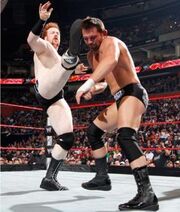
Sheamus performs the Bicycle Kick
An attacking wrestler jumps up and kicks forward with both feet in a pedaling motion with the foot that gets lifted second being extended fully to catch a charging opponent directly in the face.
Dragon whip[]
This is a leg lariat or Spinning heel-kick move which is performed after an opponent catches the leg of a wrestler who has attempted a kick of some sort (i.e. superkick or side kick), then while the opponent throws the leg out away from himself the wrestler continues to spin all the way out with his leg still extended to hit the leg lariat.
Dropkick[]
A dropkick is defined as an attack where the wrestler jumps up and kicks the opponent with the soles of both feet, this sees the wrestler twist as they jump so that when the feet connect with the opponent one foot is raised higher that the other (depending on which way they twist) and the wrestler fall back to the mat on their side, or front. This is commonly employed by light and nimble wrestlers who can take advantage of their agility.
Enzuigiri[]
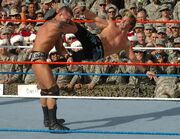
Chris Jericho performing step-up enzuigiri on Randy Orton
Enzuigiri was one of the signature moves by Antonio Inoki. The term Enzui is the Japanese word for medulla oblongata and giri means "to chop". Thus, an enzuigiri (often misspelled 'ensuigiri' or 'enzuiguri') is any attack that strikes the back of the head. It is usually associated with lighter weight class wrestlers, as well as wrestlers who have a martial arts background or gimmick. It is often a counter-move after a kick is blocked and the leg caught, or the initial kick is a feint to set up the real enzuigiri attack.
"Gentleman" Chris Adams' enzuigiri was often mistakenly called a superkick before bringing the real maneuver itself to the U.S. from his stint in Japan. In America, this maneuver was made famous by Bad News Brown, who used a running variation simply known as a running enzuigiri in which he calls it the Ghetto Blaster.
Football kick[]
Sometimes also referred to as a soccer kick. The wrestler kicks an opponent, who is sitting on the mat, vertically to their back, with the foot striking the base of the spine, and the shin striking the back of the head.
Hardcore Holly uses a variation in which he positions the opponent facing the ropes, grabs both ankles lifting the lower half of the body, with the upper body now hanging over the ropes, and delivers a firm kick between the legs to the lower abdominal region of the opponent.
Jumping high kick[]
The wrestler jumps up and kicks the opponent to the side of their head. It is properly called a Gamengiri, but due to the similar nature can be confused for an enzuigiri.
Legsweep[]
The wrestler drops to one knee and extends their other leg, then quickly pivots their body around, using their extended leg to knock away the opponent's legs.
Mule kick[]
While facing away from a charging opponent, the wrestler bends down and pushes out one foot, striking the opponent with the bottom of it.
A double mule kick variation is also possible, usually done with the wrestler facing away from the opponent, sometimes done in a corner. The wrestler jumps and kicks backwards with both legs to the opponent, hitting them with both soles of their feet. If acrobatically inclined, the wrestler can then roll forward into a standing position.
Paul London uses an elevated variation where he jumps from the second rope over a bend over opponent, and thrusts both his feet down onto the opponent's back.
A two-man variation is also possible, used by Paul London and Brian Kendrick.
Overhead kick[]
Similar to a backflip kick, this attack sees the wrestler either start by lying down or drops down on the mat while the opponent standing near their head. The wrestler lifts a leg and kicks up over their waist and chest, hitting the opponent with the top of their foot, usually in the head. Can be used as a counter to an attack from behind. For example, a wrestler attempts a full nelson, the wrestler breaks the opponent's lock, falls to the canvas and kicks them in the face with their foot.
Punt[]
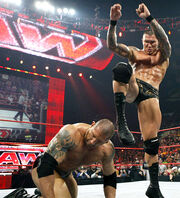
Randy Orton about to perform a running punt to Batista
Based on the punt kick used in American football, this sees the wrestler take a run up to a kneeling opponent and strike him in the head with the sole of his foot. WWE superstar Randy Orton has been using this move ever since 2007 and has kayfabe knocked many of his opponents into "concussion".
Rolling wheel kick[]
It is also known as an Abisegiri or a Rolling Koppou Kick. The wrestler rolls towards a standing opponent, extending a leg which connects with the back, chest, or head of the opponent.
Roundhouse kick[]
Properly speaking, a roundhouse kick in wrestling is a variation of a shoot kick with a slight difference. While in the later (a proper roundhouse kick in execution) the attack stops after connecting the opponent, in a roundhouse kick the wrestler will keep spinning well passed a sitting/kneeling opponent's head or a standing opponent's ribcage, giving a 180 or even a full 360° turn.
Savate kick[]
The most commonly used kick which is referred to as a "Savate kick" in wrestling is the chassé, a piston-action kick, with the sole of the foot to an opponent's head or chin. This kick is in some ways similar to, but not considered, a Superkick.
Scissors kick[]
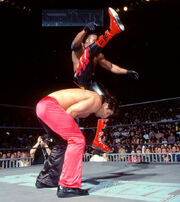
A version of a leg drop, which is performed on an opponent who is standing, bent over, usually in the middle of the ring. This sees a wrestler bounces off the ropes, jumps—driving his leg(s) into the back of the head and the neck of the opponent, forcing them face first into the floor. Also known as a Jumping Axe Kick, or a Butterfly Kick. In the West, this move is usually associated with Booker T.
Shoot kick[]
A kickboxing-style kick with the shin (generally protected by a shin guard) striking an opponent's face or chest. This move originated in the Japanese UWF and is used in shoot-style environments and by many Japanese wrestlers, most notably Toshiaki Kawada, whose usage of this kick resulted in it being called the Kawada Kick on some occasions.
Sole kick[]

Justin Gabriel performing Jumping Spinning Sole Kick
A thrust kick where the wrestler turns his torso away from the opponent while at the same time lifting his leg horizontally and extending it forward, striking the opponent in the torso with the sole of his foot. Tiger Mask and Último Dragón use it as a part of their kick combination, which consists of a shoot kick and a spin kick, followed by the jumping rolling sole butt kick.
A spin kick variation sees the wrestler spin around and then perform the sole butt kick with his outer leg, which is known as a Rolling sole kick in Japan. There is also jumping variation where the wrestler jumps straight up, spins in the air, and then delivers the sole butt with his outer leg targeting the head of the opponent.
Spin kick[]
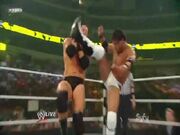
Justin Gabriel performing a spin kick on Wade Barrett
A high kick which gains power and momentum from spinning in place. Similar to the spinning heel kick or a reverse roundhouse kick, but the wrestler does not jump off the ground, making the move a leg lariat of sorts. It is common to see this move executed after an opponent is Irish whipped off the ropes. In Mexico, it is known as La Filomena.
Spinning heel kick[]
This move usually involves the wrestler spinning 360 degrees as they jump so that his or her body is somewhat horizontal, before hitting their opponent with back of his/her leg(s) or heel(s) on the face, neck or chest.
Stomp[]
Also known as a foot stomp, this attack sees a wrestler stamp his foot on any part of a fallen opponent. One variation of the stomp called the Garvin Stomp, named after its innovator Ron Garvin, sees a wrestler perform a series of stomps all over the body of a fallen opponent in the order of left arm, left chest, left stomach, left upper leg, left lower leg, right lower leg, right upper leg, right stomach, right chest, right arm, and finally the jaw.
Double foot stomp[]
When a wrestler jumps and stamps both feet on any part of an opponent. Also known as a double stomp.
Superkick[]
A high side thrust kick with the sole of the foot to an opponent's head or chin, usually preceded by a sidestep, often referred to as a Shuffle side kick, Crescent Kick, or just a Side kick. The wrestler will often slap their thigh to generate an appropriate sound effect. It is the equivalent of the Sokuto Geri or Yoko Geri used in Karate. A popular variation of the superkick is Shawn Michaels' Sweet Chin Music.
Tiger feint kick[]
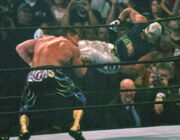
Rey Mysterio is performing a tiger feint kick which he called 619 on Eddie Guerrero
The Tiger Feint Kick, named after Tiger Mask, and innovated by the first Tiger Mask, Satoru Sayama, is a move in which a wrestler jumps through the second and top rope while holding on to the ropes, and uses the momentum to swing back around into the ring, and was originally performed as a fake dive to make opponents and fans think that the wrestler was about to dive through the ropes to opponents outside the ring. This move requires high agility, and is mainly used by smaller wrestlers in Japan and Mexico.
A variation of this move, innovated by the Japanese wrestler MIKAMI, who calls it the Mickey Boom, sees an opponent being hung over the second rope facing the outside, as MIKAMI swings around back to the ring his feet would hit the prone opponent in the head. In the western world, this version is best known as the 619 as named by Rey Mysterio in reference to the area code of San Diego, Mysterio's hometown.
